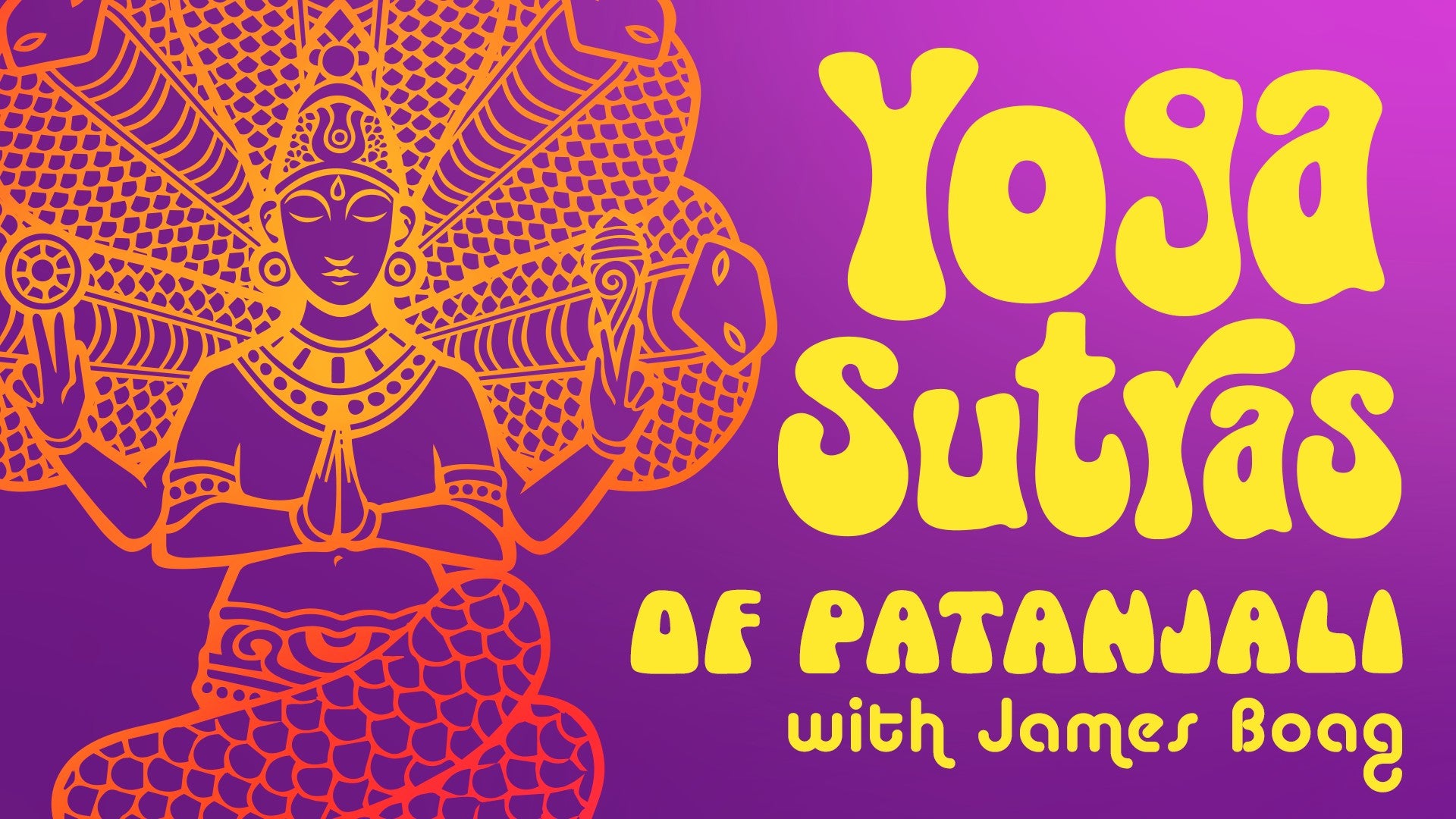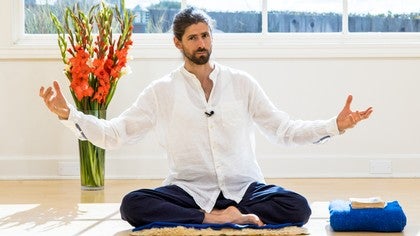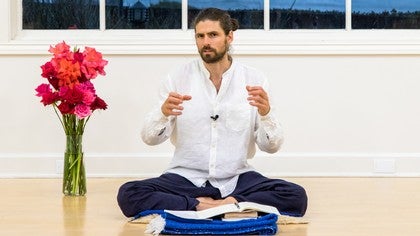Description
About This Video
Transcript
Read Full Transcript
So, the Yoga Sutra is one of the treasure texts of the yoga tradition. And I think also these days, given the interest in yoga, it's one of those texts that sometimes people come to a bit more readily than some of the other texts because it has the word yoga in its title. If you're interested in learning more about yoga and you go to a bookshop and you want to go to a kind of source text, part of the tradition, you'll see lots of other words, Upanishad, Gita, and different words that you might not have come across before. But if you see Yoga Sutra, this must be about yoga. And the first time I encountered the Yoga Sutra, I was very fortunate because the first person that I studied it with, he presented it so wonderfully, so beautifully.
And the way he described the Yoga Sutra was as the stitches that weave together the fabric of unity, which I think is so beautiful. I'll say again, he says that the stitches that weave together the fabric of unity. As the years have gone by and I've explored the sutras more, I also think of them, the Yoga Sutra, as a text that basically encodes the principles and the teachings that can help us weave greater harmony into the fabric of our lives. And this is what we're really working with. What is yoga?
It's the practical school of Indian philosophy. And so its concern is practical. It's like, what is life about? What do we want when we're alive? For me, we want to be happy.
But this word happy has, you know, sometimes the idea like happy and sad. I think maybe a better word, we would like to feel content. We would like to feel fulfilled, satisfied, whole. And so this is the idea of yoga, it's how to cultivate wholeness. How to be content, easy, steady, where we are, in the grounded reality of life with all its change.
Then sutra, sutra means stitch in Sanskrit and it also means thread. And if we think of a stitch like this shirt, for example, the stitches here are very small. But they can hold a vast body of fabric. And this is the idea of the sutra form in Sanskrit literature. The sutra form is ultra-concise, ultra-condensed.
So the yoga sutra is a text that distills and encodes a vast body of practical teaching into a very concise presentation. Now when we start to work with the yoga sutra, it's important to recognize some of the particularities of the sutra form. Because the sutra, as we've mentioned, it's the stitch and the thread. But the whole text is woven, if you like, with the same thread. Because I've seen published editions of the text translated as the aphorisms of potentially the author.
But an aphorism is not really the same as a sutra. Aphorism is a standalone short piece of pithy wisdom. But the sutra, the idea is that each sutra is part of the same sutra. Each stitch is woven with the same thread. The whole text is mutually supportive.
Each sutra basically grows from that which has preceded it. And if we are uncertain of the import of a particular sutra, we can go back to the governing sutra, which is given at the beginning, to get more of an idea. In the Sanskrit tradition, one thing that has happened is that this tradition was developed before libraries in the way that we know them now, and before you could store lots of information on a hard drive. Now in recent times, we've seen the condensation of information into smaller and smaller containers. Computers have got more and more compact.
Little drives contain fast bodies of information. But this human endeavor to condense a lot of useful information into a very concise form is not new. And the Indian research scientists and explorers of thousands of years ago, they were doing the same thing. And in the Yog tradition, we find that texts have been given in ways that encode vast teachings in concise forms. So we have, for example, the Bhagavad Gita, which is written in poetry, and poetry that is quite dense.
Poetry is able to convey multiple meanings and codify lots of information in a relatively concise form. But the sutra takes it even further. And this is why sutras are basically untranslatable. So I say that again. It's not really possible to translate the yoga sutras, because the equivalents that we might use for the Sanskrit words in English or other modern languages don't have the same reach as the original Sanskrit.
Because the idea of a sutra is that it is very concise, it is very precise, it is thorough, it is not ambiguous. But it is also this thing they call in Sanskrit vishwatah mukah, or vishwatoh mukah, meaning that it faces out in every direction. It looks out in every direction. It shines its meaning out in every direction. So the idea is basically a sutra is like a lighthouse.
And wherever you are in the ocean of life, if you look at that sutra, if you look into it, it can inform you relative to where you are. And if you look at it again and again, it can inform you anew. It can inform you in fresh ways. This is the beauty of this text, it's so distilled. And the sutra is like a lighthouse.
Every time you look at it, it can speak to you differently. And so it's not the case that there's one correct translation. There's many, many translations that are very helpful. But the real idea is we have to be the translator. These yoga texts, there's the idea, they're not telling us the answer, they're giving us a frame of reference for skillful, ongoing inquiry.
And so we keep looking into them, we keep exploring through the principles they share with us. And the idea is that the text is like a miracle mirror text. And every time we look into it, it can show us something more, it can teach us something more. So we, if you like, we become the translator when we engage with the text. We translate its timeless practical wisdom into that which is timely and necessary for us as we explore reality here and now.
So the sutra is this very distilled form. But this is the yoga sutra. So before we talk a little bit more about what sutras are, what is yoga? So yoga, the root word, the root verb is yuj. Now it means to join, to conjoin, to bring together, to yoke.
If you have a bullock and a cart, there is the yoke that joins them, that allows the cart to be pulled by the oxen, for example. So yoga is the means of connection. It's that which facilitates connection. But this root also means to meditate. Now what does meditate mean?
If we think of the word medistate, meditar, estar en el medio, in Spanish for example. So it's the state of being centered. So we've got joining, conjoining, joining together, and we've got meditating. The idea in yoga, at the grand level, some say, is to join the individual soul with the supreme soul, to become connected to the oneness that is underlying everything, wonderful. But before we think about that, we have to join all the parts of our self.
There's no question of merging our soul into the infinite if we haven't got a thorough understanding of who we are here and now. So first, we practice cultivating harmony and integration within this body, within this microcosm. The practice of meditation means to center ourselves, to gather all our parts around that central underlying conscious essence so we can know all of ourselves. When we become a cohesive integrated whole, when we become a true individual in the sense of an indivisible entity, a person that is no longer split and fragmented, then we can access this greater sense of unity. So yoga, coming together, harmonizing, cultivating centeredness, balance, equipoise, and sutras, the stitches that tell us how to do this.
And when we come to the text of the Yoga Sutra, we encounter a particular master or yogin called Patanjali. And he is the sage that bequeathed us this amazing miracle, mirror text of the Yoga Sutra. So if we're going to study this text and explore it, it is important to consider who Patanjali was. Now at this point I have to say, I don't know, because I didn't meet him. But what I can say, having explored the text, is that the person who wrote this text was not an average ordinary human being.
He wasn't just a skillful author who could write a nice page turning bestseller. This author was altogether a kind of super human, like a Mozart or a Tesla. This person was a yogin, meaning one who's established in yoga, in integration. And we know this because Patanjali demonstrates it in the way he sets out his text, which is just jaw-droppingly beautiful. Because the text incarnates, if you like, embodies, demonstrates yoga principles.
It's so inclusive. There are no negative constructions in the text at all. And we talk about the text, it's also important to highlight Patanjali, the great sage. He's not just venerated amongst people who are exploring yoga. When I was studying Sanskrit in India, we would often invoke Patanjali when we would study Sanskrit.
Because Patanjali, as well as being a great yogin, he is a great grammarian. But we can go further than that. Patanjali is not just a great grammarian. In the pantheon of Sanskrit grammarians, he is the last word. In Sanskrit, there is a great sage called Parnini, who wrote this work called the Ashta jai.
It's basically eight sections of work that encode and describe the Sanskrit language. And it's a truly epic work. And it's quite difficult to approach. But many of the great figures of modern linguistics acknowledge that everything that they are discovering, everything that they're exploring, is all encoded in Parnini's work. But after Parnini gave the Ashta jai, which define and describe the Sanskrit language, describe the grammar, there was a commentator on this work called Vararuchi.
And then came Patanjali. And Patanjali wrote this work called the Mahabhasha, which means the great commentary. Now my Sanskrit teacher, my main Sanskrit teacher, is not a man who is given to hyperbole. But one day we were having a class and he said, Patanjali, oh yes. And the Mahabhasha, his great commentary on Parnini's Ashta jai, is without doubt the greatest work in the history of Sanskrit literature.
Now this from a man who is not at all prone to hyperbole is quite a statement, like wow. And there's so much beautiful literature in Sanskrit. So wow, this is a really strong statement. In other words, Patanjali is the genius of geniuses when it comes to language. And this is important to note when we get into a sutra text.
Because the sutra basically condenses information to the most distilled form possible. But then has to present it in a way that is clear, concise, without ambiguity and can shine its light out in all directions. So to write like that is very difficult. But Patanjali, he was very much up to the task. He was a sutra kara, one who writes sutras par excellence.
Really off the scale amazing when it comes to working with language. And so Patanjali, he was able to encode vast, vast bodies of practical teaching into this ultra distilled sutra form. The sutras basically, they are like mnemonics, they're like memory aids. The sutra, it's like a point, if you like. That's actually the, in Latin language, it's like Italian, for example.
A stitch is called un punto, a point. It says that the sutra is like a point. You go to that point and it elaborates, it opens up all of this teaching. When you learn the sutra, to study it doesn't just mean to study the words. Because this is yoga, the practical school of Indian philosophy.
And in yoga, to study means to practice. To practice means to study. It's all about exploration and inquiry. When you study the text, you also explore its practical implications in the whole arena of your everyday life. And then, the sutras start to open up.
But the idea is when you learn the sutras, let's say you find yourself in a particular type of situation, and one of the principles, or some of the principles in the sutras would be helpful, you can call them to mind, readily, relatively easily, once you've spent time engaging with them, once you've kind of installed them into your hardware, as it were. The sutra, like, I don't know, computers are changing so much these days, so quickly, but on the one that I have, which might be relatively antiquated, there's a desktop and I can click to access a particular type of program, for example. And when I click it, the program opens up and I can use its resources. Same idea when we study the sutras. The idea is that we practice the sutras, so we install them into our very being, and then we can call on them whenever we need them.
So it's always practical, it's always about what we do. The study, it's not just about the book, it's not just about the words, the idea is these words are related to our practical experience, to things that we do.
Yoga Sutras of Patanjali: Start Where You Are
Comments
Thank you so much for your thoughtful feedback. We hope to offer a wide variety of perspective. Meanwhile, it is James's sincere love of the text that inspires us.
Perhapas you might enjoy David Gordon White's Season 1 of Histories of Yoga and Season 1 and 2 of
Heart of the Tradition with Ravi Ravindra.
So glad you are here.
Warmly, Kira
You need to be a subscriber to post a comment.
Please Log In or Create an Account to start your free trial.


















